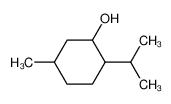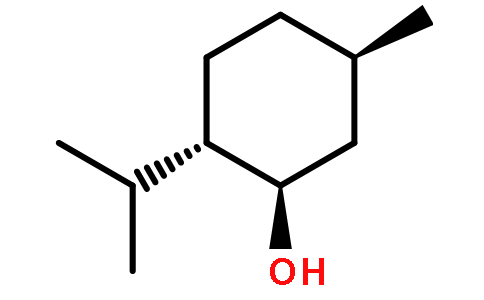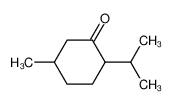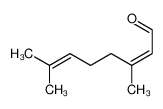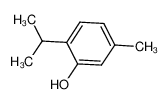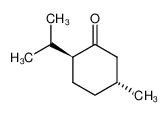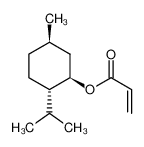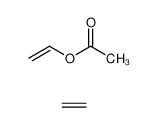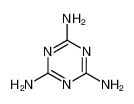| Product name | (+/-)-p-Menthan-3-ol |
|---|
| Product number | - |
|---|---|
| Other names | MENTHOL |
| Identified uses | For industry use only. Fragrances |
|---|---|
| Uses advised against | no data available |
| Company | MOLBASE (Shanghai) Biotechnology Co., Ltd. |
|---|---|
| Address | Floor 4 & 5, Building 12, No. 1001 North Qinzhou Road, Xuhui District, Shanghai, China |
| Telephone | +86(21)64956998 |
| Fax | +86(21)54365166 |
| Emergency phone number | +86-400-6021-666 |
|---|---|
| Service hours | Monday to Friday, 9am-5pm (Standard time zone: UTC/GMT +8 hours). |
Skin irritation, Category 2
2.2 GHS label elements, including precautionary statements| Pictogram(s) | 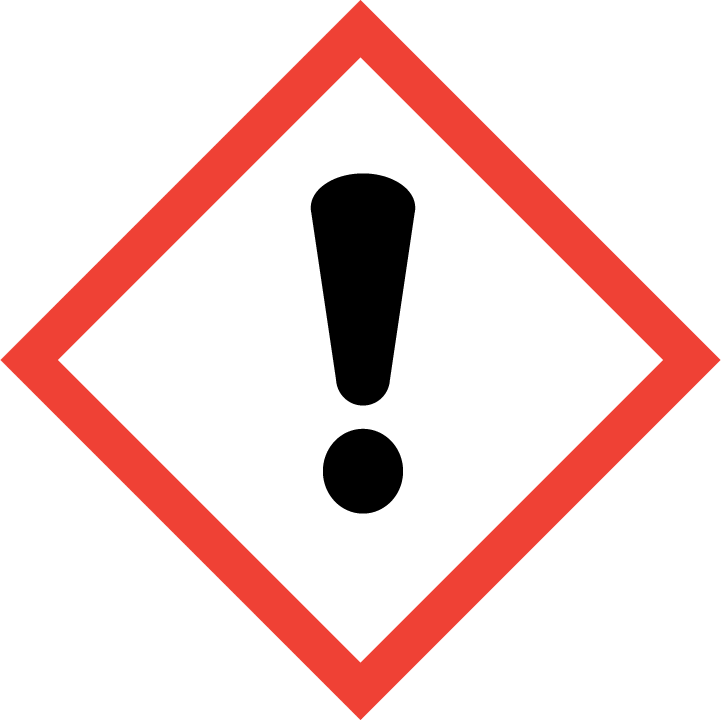 |
|---|---|
| Signal word | Warning |
| Hazard statement(s) | H315 Causes skin irritation |
| Precautionary statement(s) | |
| Prevention | P264 Wash ... thoroughly after handling. P280 Wear protective gloves/protective clothing/eye protection/face protection. |
| Response | P302+P352 IF ON SKIN: Wash with plenty of water/... P321 Specific treatment (see ... on this label). P332+P313 If skin irritation occurs: Get medical advice/attention. P362+P364 Take off contaminated clothing and wash it before reuse. |
| Storage | none |
| Disposal | none |
none
3.Composition/information on ingredients 3.1 Substances| Chemical name | Common names and synonyms | CAS number | EC number | Concentration |
|---|---|---|---|---|
| (+/-)-p-Menthan-3-ol | (+/-)-p-Menthan-3-ol | 15356-70-4 | none | 100% |
Consult a physician. Show this safety data sheet to the doctor in attendance.
If inhaledIf breathed in, move person into fresh air. If not breathing, give artificial respiration. Consult a physician.
In case of skin contactWash off with soap and plenty of water. Consult a physician.
In case of eye contactRinse thoroughly with plenty of water for at least 15 minutes and consult a physician.
If swallowedNever give anything by mouth to an unconscious person. Rinse mouth with water. Consult a physician.
4.2 Most important symptoms/effects, acute and delayedSYMPTOMS: Symptoms of exposure to this compound may include irritation of the skin, eyes, mucous membranes and upper respiratory tract. Exposure may also cause hypersensitivity reactions including contact dermatitis, spasms of the glottis and collapse in young children, urticaria, flushing, headache, insomnia, unsteady gait, thick speech, tremor of the hands, mental confusion, depression, vomiting, cramp in the legs and bradycardia. Exposure to compounds of this class may cause painless blanching or erythema, possible corrosion, profuse sweating, intense thirst, nausea, diarrhea, cyanosis from methemoglobinemia, hyperactivity, stupor, blood pressure fall, hyperpnea, abdominal pain, hemolysis, convulsions, coma and pulmonary edema followed by pneumonia. If death from respiratory failure is not immediate, jaundice and oliguria or anuria may occur. These compounds occasionally cause skin sensitization. ACUTE/CHRONIC HAZARDS: This compound may be harmful by inhalation, ingestion or skin absorption. It is an irritant of the skin and eyes. It is also irritating to the mucous membranes and upper respiratory tract. When heated to decomposition it emits acrid smoke and toxic fumes of carbon monoxide and carbon dioxide.
4.3 Indication of immediate medical attention and special treatment needed, if necessary/SRP:/ Immediate first aid: Ensure that adequate decontamination has been carried out. If patient is not breathing, start artificial respiration, preferably with a demand-valve resuscitator, bag-valve-mask device, or pocket mask, as trained. Perform CPR as necessary. Immediately flush contaminated eyes with gently flowing water. Do not induce vomiting. If vomiting occurs, lean patient forward or place on left side (head-down position, if possible) to maintain an open airway and prevent aspiration. Keep patient quiet and maintain normal body temperature. Obtain medical attention. /Aromatic hydrocarbons and related compounds/
5.Fire-fighting measures 5.1 Extinguishing media Suitable extinguishing mediaUse water spray, alcohol-resistant foam, dry chemical or carbon dioxide. Wear self-contained breathing apparatus for firefighting if necessary.
5.2 Specific hazards arising from the chemicalThis chemical is combustible.
5.3 Special protective actions for fire-fightersWear self-contained breathing apparatus for firefighting if necessary.
6.Accidental release measures 6.1 Personal precautions, protective equipment and emergency proceduresUse personal protective equipment. Avoid dust formation. Avoid breathing vapours, mist or gas. Ensure adequate ventilation. Evacuate personnel to safe areas. Avoid breathing dust. For personal protection see section 8.
6.2 Environmental precautionsPrevent further leakage or spillage if safe to do so. Do not let product enter drains. Discharge into the environment must be avoided.
6.3 Methods and materials for containment and cleaning upACCIDENTAL RELEASE MEASURES Personal precautions, protective equipment and emergency procedures Use personal protective equipment. Avoid dust formation. Avoid breathing vapors, mist or gas. Ensure adequate ventilation. Evacuate personnel to safe areas. Avoid breathing dust. For personal protection see section Environmental precautions Do not let product enter drains. Methods and materials for containment and cleaning up Pick up and arrange disposal without creating dust. Sweep up and shovel. Keep in suitable, closed containers for disposal.
7.Handling and storage 7.1 Precautions for safe handlingAvoid contact with skin and eyes. Avoid formation of dust and aerosols. Avoid exposure - obtain special instructions before use.Provide appropriate exhaust ventilation at places where dust is formed. For precautions see section 2.2.
7.2 Conditions for safe storage, including any incompatibilitiesKeep container tightly closed in a dry and well-ventilated place.
8.Exposure controls/personal protection 8.1 Control parameters Occupational Exposure limit valuesno data available
Biological limit valuesno data available
8.2 Appropriate engineering controlsHandle in accordance with good industrial hygiene and safety practice. Wash hands before breaks and at the end of workday.
8.3 Individual protection measures, such as personal protective equipment (PPE) Eye/face protectionSafety glasses with side-shields conforming to EN166. Use equipment for eye protection tested and approved under appropriate government standards such as NIOSH (US) or EN 166(EU).
Skin protectionWear impervious clothing. The type of protective equipment must be selected according to the concentration and amount of the dangerous substance at the specific workplace. Handle with gloves. Gloves must be inspected prior to use. Use proper glove removal technique(without touching glove's outer surface) to avoid skin contact with this product. Dispose of contaminated gloves after use in accordance with applicable laws and good laboratory practices. Wash and dry hands. The selected protective gloves have to satisfy the specifications of EU Directive 89/686/EEC and the standard EN 374 derived from it.
Respiratory protectionWear dust mask when handling large quantities.
Thermal hazardsno data available
9.Physical and chemical properties| Physical state | PHYSICAL DESCRIPTION: White crystalline solid with a peppermint odor and taste. |
|---|---|
| Colour | White crystals /89-78-1/ |
| Odour | Peppermint odor /dl-Menthol/ |
| Melting point/ freezing point | 34-36ºC(lit.) |
| Boiling point or initial boiling point and boiling range | 216ºC(lit.) |
| Flammability | no data available |
| Lower and upper explosion limit / flammability limit | no data available |
| Flash point | 93.33°C |
| Auto-ignition temperature | no data available |
| Decomposition temperature | no data available |
| pH | no data available |
| Kinematic viscosity | no data available |
| Solubility | less than 1 mg/mL at 21.11°C |
| Partition coefficient n-octanol/water (log value) | log Kow = 3.2 |
| Vapour pressure | 1.13E-08mmHg at 25°C |
| Density and/or relative density | 0.89 g/mL at 25ºC(lit.) |
| Relative vapour density | 5.4 (Relative to Air) |
| Particle characteristics | no data available |
no data available
10.2 Chemical stabilityStable under recommended storage conditions.
10.3 Possibility of hazardous reactionsCombustible liquid.D,L-MENTHOL is incompatible with butyl chloral hydrate, camphor, phenol, chloral hydrate, Exalgine, betanaphthol, resorcinol or thymol in triturations; potassium permanganate, chromium trioxide and pyrogallol. It is also incompatible with strong oxidizers.
10.4 Conditions to avoidno data available
10.5 Incompatible materialsStrong oxidizing agents
10.6 Hazardous decomposition productsWhen heated to decomposition it emits acrid smoke and irritating fumes.
11.Toxicological information Acute toxicity- Oral: LD50 Rat oral 2900 mg/kg /DL-Menthol/
- Inhalation: no data available
- Dermal: no data available
no data available
Serious eye damage/irritationno data available
Respiratory or skin sensitizationno data available
Germ cell mutagenicityno data available
Carcinogenicityno data available
Reproductive toxicityno data available
STOT-single exposureno data available
STOT-repeated exposureno data available
Aspiration hazardno data available
12.Ecological information 12.1 Toxicity- Toxicity to fish: LC50; Species: Pimephales promelas (Fathead minnow) age 30 days, length 17.6 mm, weight 0.079 g; Conditions: freshwater, flow through, 24.4°C, pH 7.7, hardness 44.5 mg/L CaCO3, alkalinity 44.5 mg/L CaCO3, dissolved oxygen 6.8 mg/L; Concentration: 18900 ug/L for 96 hr /99% purity
- Toxicity to daphnia and other aquatic invertebrates: no data available
- Toxicity to algae: no data available
- Toxicity to microorganisms: no data available
AEROBIC: Menthol, present at 100 mg/L, reached 0% of its theoretical BOD in 4 weeks using an activated sludge inoculum at 30 mg/L in the Japanese MITI test(1). However, other reports indicate that DL-menthol is readily biodegradable(2).
12.3 Bioaccumulative potentialBCF values of <4.6-11 and <0.5-15 were reported using carp (Cyprinus carpio) which were exposed over an 8-week period to menthol concentrations of 20 and 200 ppm, respectively(1). According to a classification scheme(2), these BCFs suggest bioconcentration in aquatic organisms is low(SRC).
12.4 Mobility in soilUsing a structure estimation method based on molecular connectivity indices(1), the Koc of menthol can be estimated to be 88(SRC). According to a classification scheme(2), this estimated Koc value suggests that menthol is expected to have high mobility in soil.
12.5 Other adverse effectsno data available
13.Disposal considerations 13.1 Disposal methods ProductThe material can be disposed of by removal to a licensed chemical destruction plant or by controlled incineration with flue gas scrubbing. Do not contaminate water, foodstuffs, feed or seed by storage or disposal. Do not discharge to sewer systems.
Contaminated packagingContainers can be triply rinsed (or equivalent) and offered for recycling or reconditioning. Alternatively, the packaging can be punctured to make it unusable for other purposes and then be disposed of in a sanitary landfill. Controlled incineration with flue gas scrubbing is possible for combustible packaging materials.
14.Transport information 14.1 UN Number| ADR/RID: UN1888 | IMDG: UN1888 | IATA: UN1888 |
| ADR/RID: CHLOROFORM |
| IMDG: CHLOROFORM |
| IATA: CHLOROFORM |
| ADR/RID: 6.1 | IMDG: 6.1 | IATA: 6.1 |
| ADR/RID: III | IMDG: III | IATA: III |
| ADR/RID: no | IMDG: no | IATA: no |
no data available
14.7 Transport in bulk according to Annex II of MARPOL 73/78 and the IBC Codeno data available
15.Regulatory information 15.1 Safety, health and environmental regulations specific for the product in question| Chemical name | Common names and synonyms | CAS number | EC number |
|---|---|---|---|
| (+/-)-p-Menthan-3-ol | (+/-)-p-Menthan-3-ol | 15356-70-4 | none |
| European Inventory of Existing Commercial Chemical Substances (EINECS) | Listed. | ||
| EC Inventory | Listed. | ||
| United States Toxic Substances Control Act (TSCA) Inventory | Not Listed. | ||
| China Catalog of Hazardous chemicals 2015 | Not Listed. | ||
| New Zealand Inventory of Chemicals (NZIoC) | Not Listed. | ||
| Philippines Inventory of Chemicals and Chemical Substances (PICCS) | Not Listed. | ||
| Vietnam National Chemical Inventory | Not Listed. | ||
| Chinese Chemical Inventory of Existing Chemical Substances (China IECSC) | Listed. | ||
| Creation Date | Aug 12, 2017 |
|---|---|
| Revision Date | Aug 12, 2017 |
- CAS: Chemical Abstracts Service
- ADR: European Agreement concerning the International Carriage of Dangerous Goods by Road
- RID: Regulation concerning the International Carriage of Dangerous Goods by Rail
- IMDG: International Maritime Dangerous Goods
- IATA: International Air Transportation Association
- TWA: Time Weighted Average
- STEL: Short term exposure limit
- LC50: Lethal Concentration 50%
- LD50: Lethal Dose 50%
- EC50: Effective Concentration 50%
- IPCS - The International Chemical Safety Cards (ICSC), website: http://www.ilo.org/dyn/icsc/showcard.home
- HSDB - Hazardous Substances Data Bank, website: https://toxnet.nlm.nih.gov/newtoxnet/hsdb.htm
- IARC - International Agency for Research on Cancer, website: http://www.iarc.fr/
- eChemPortal - The Global Portal to Information on Chemical Substances by OECD, website: http://www.echemportal.org/echemportal/index?pageID=0&request_locale=en
- CAMEO Chemicals, website: http://cameochemicals.noaa.gov/search/simple
- ChemIDplus, website: http://chem.sis.nlm.nih.gov/chemidplus/chemidlite.jsp
- ERG - Emergency Response Guidebook by U.S. Department of Transportation, website: http://www.phmsa.dot.gov/hazmat/library/erg
- Germany GESTIS-database on hazard substance, website: http://www.dguv.de/ifa/gestis/gestis-stoffdatenbank/index-2.jsp
- ECHA - European Chemicals Agency, website: https://echa.europa.eu/





